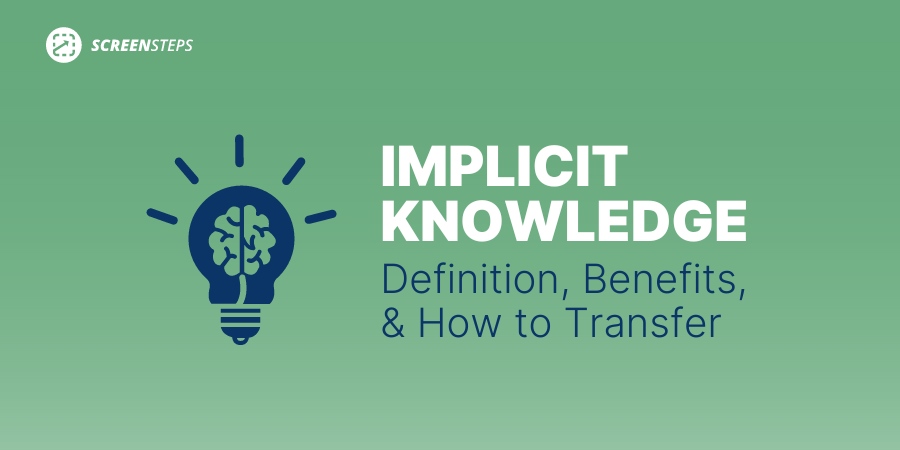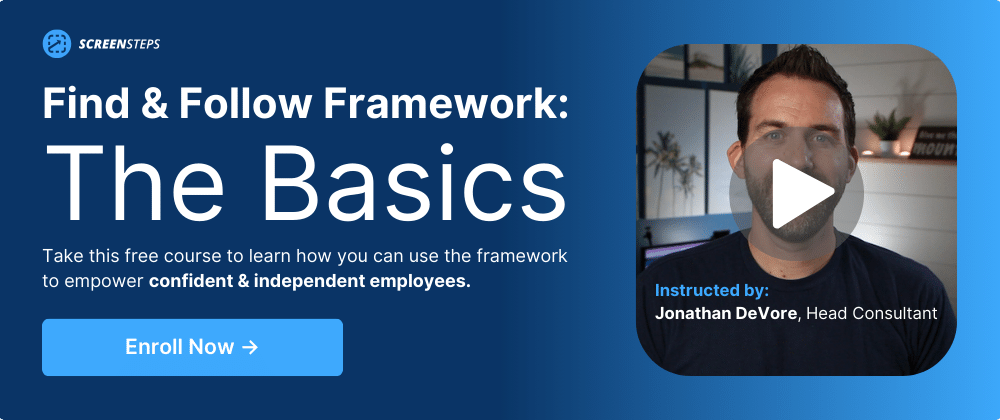Implicit Knowledge: Definition, Benefits, & How to Transfer It
Knowledge management is complicated. When you think of training new hires, it seems like a simple thing. But there are different types of knowledge you need to transfer to your employees and people receive that knowledge through different learning methods.
One of the main types of knowledge is implicit knowledge.
At ScreenSteps — a knowledge ops solution — we help companies transfer knowledge more efficiently with our Find & Follow Framework. This includes the abstract implicit knowledge.
In this blog post, you’ll learn more about implicit knowledge and how to transfer it. You can even download a free new hire training playbook. It will help you train employees on implicit knowledge (and other types of knowledge) more efficiently.
What is implicit knowledge?
Implicit knowledge is foundational knowledge. It draws on experience. It helps you apply explicit knowledge. When using implicit knowledge, you are considering the “How” behind a specific task.
It is the type of knowledge that can be transferred from job to job. It is your soft skills or general job awareness. It is so ingrained in people that it is almost our subconscious knowledge.
Implicit knowledge is ingrained in our actions and behavior. This is background or contextual knowledge that comes with understanding your industry.
Implicit knowledge examples
Implicit knowledge is difficult to articulate because it is foundational knowledge people build on.
For example, everyday life examples of implicit knowledge are knowing how to walk, ride a bike, or rollover.
Some business examples of implicit knowledge are:
- Soft skills for answering calls in a contact center (like how to react with empathy)
- Negotiating in sales
- Certain IT troubleshooting that doesn’t already have a troubleshooting procedure
- Project management surrounding timelines
- Leadership decision-making on company direction
Implicit vs explicit vs tacit knowledge
The three main types of knowledge to transfer in business are implicit knowledge, explicit knowledge, and tacit knowledge.
While these types of knowledge are similar, they are all slightly different. Plus, the way you transfer that knowledge is different.
Implicit knowledge
As a quick review, implicit knowledge is the intangible knowledge that people acquire via experience.
Explicit knowledge
Explicit knowledge is knowledge that you can easily capture. This is information that you can easily document, such as a how-to article or step-by-step procedure. It revolves around facts, procedures, and other information you typically find in manuals.
Think of explicit knowledge as actionable knowledge. You can transfer explicit knowledge through clearly written instructions.
Tacit knowledge
Tacit knowledge is what people gain through experience. It is the knowledge people accumulate through past encounters as well as intuition.
It is a type of applied knowledge that is gained through personal experiences, practice, and hands-on learning.
5 benefits of developing implicit knowledge
While implicit knowledge is difficult to measure, learning implicit knowledge is an important part of the training process. There are many benefits to developing implicit knowledge, including these five outcomes:
- Speed up decision-making: Because implicit knowledge is based on contextual knowledge, it is easier for employees to quickly discern the best actions.
- Encourage continuous learning: With the foundation of implicit knowledge, employees have space to build off that knowledge. There is even room for creative problem-solving.
- Improved knowledge sharing & collaboration: When employees share implicit knowledge, it helps them learn from each other’s experiences, advancing individual learning faster.
- Shorten learning times: Along with improving collaboration, sharing knowledge helps shorten learning times.
- Develop expertise: As employees learn from their experiences, they can provide more input and ideas.
A challenge when capturing implicit knowledge
Capturing implicit knowledge is challenging because of its nuanced and experience-based nature. It is hard to pass on experiential knowledge.
The important thing to overcoming these obstacles is having a plan. You need to know how you will transfer implicit knowledge, which is what the next section is about.
How to capture and transfer implicit knowledge (4 strategies)
Implicit knowledge is difficult to teach since it relies on life experience and subconsciously connecting the dots between the “what” (explicit knowledge) and the “how” (implicit knowledge).
Some of the best practices for helping employees learn implicit knowledge include these four strategies.
1. Providing new hires with a mentor
When you onboard a new hire, provide them with a peer mentor. During training, they can shadow these experienced mentors. Observing will help them see how things work.
They can also practice different scenarios with these mentors so that they can build experience with your company policies and procedures and is a safe “on-the-job” experience.
This provides new hires with a trusted tenured employee who can support them by answering questions. And it is less intimidating than interrupting the supervisor for help.
2. Sharing relatable stories and anecdotes
Use relatable stories, anecdotes, and metaphors to help your employees make connections and learn faster.
Relate your training material to day-to-day activities. This can be anything from. cooking, painting, sports, riding a bike, following GPS directions, etc.
The idea is that your learners will have experience with these metaphors which will help them understand what you are teaching them faster.
3. Partnering pairs of learners
Learning is better with a buddy. In your training classes, pair up learners. They can be partners for practice activities.
This provides learners with opportunities to teach each other. For example, one new hire may pick up on a concept before the other. The first learner can help explain the concept and answer questions for the struggling learner. This helps both learners better understand the material.
You can switch partnered learners throughout the training experience. Partnered learning helps build trust and allows new learners to practice what they are being taught.
4. Leveraging technology
Digital tools and platforms can aid in capturing implicit knowledge. Use software services to capture, share, and access implicit knowledge.
Since implicit knowledge deals with foundational knowledge, you can create trainings that provide general background knowledge on concepts, terms, and other basic information. We refer to these as foundational courses.
These can be in video or text format. Software — like a learning management system (LMS) or Knowledge Ops Platform — allows you to prepare self-service, reusable courses.
You can also create a knowledge repository where employees can search your centralized knowledge hub and provide your employees with answers. A Knowledge Ops Platform also does this as does a knowledge base software.
Transfer implicit knowledge faster with the Find & Follow Framework
Transferring knowledge from your experts to your new hires takes multiple approaches. When you have a training and employee support program that works cohesively together, it is faster and easier to transfer knowledge.
The Find & Follow Framework is that cohesive program that helps you train and support employees on the job. With Find & Follow and a ScreenSteps knowledge ops platform, companies onboard new hires in 30 days or less.
Want to build a Find & Follow Training for your business?
Take the free Find & Follow Framework courses. The 30-minute course provides an overview of the framework and how it improves knowledge transfer. The course will help you determine whether Find & Follow is the training solution your company needs.




